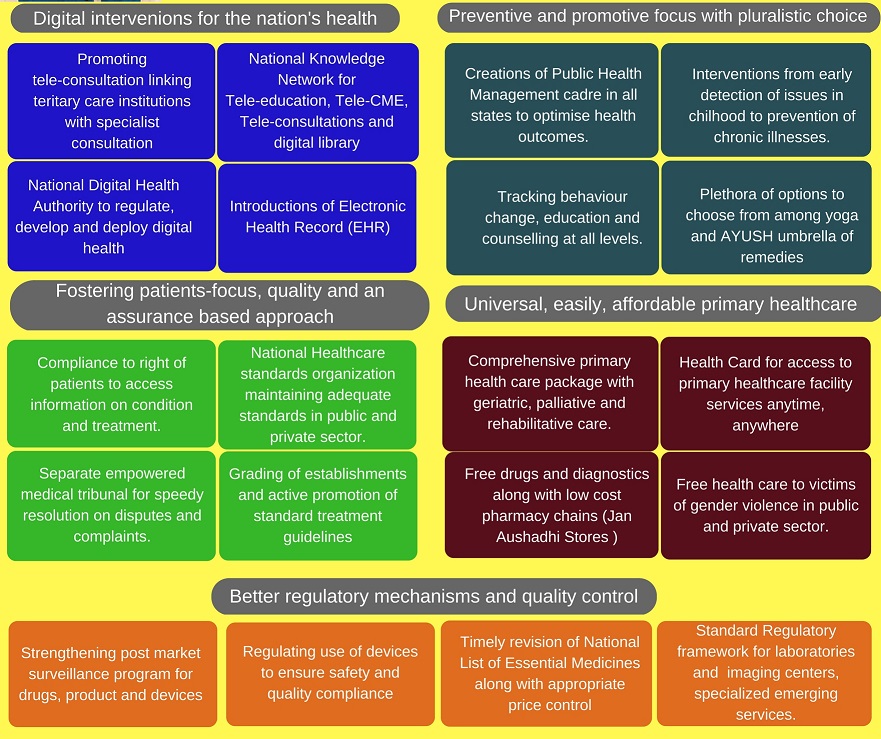Why in news?
The National Health Policy, 2017, was approved by the Union Cabinet which will replace the previous policy adopted in 2002.
What are the key highlights?
- The broad principles of the Policy are centered on professionalism, integrity and ethics, equity, affordability, universality, patient centered and quality of care, accountability and pluralism.
- It aims to achieve universal access to good quality health care services without anyone having to face financial hardship as a consequence.
- It intends on gradually increasing public health expenditure to 2.5% of the GDP.
- It proposes free drugs, free diagnostics and free emergency and essential healthcare services in public hospitals.
- The policy advocates allocating two-thirds (of resources to primary care.
- It proposes two beds per 1,000 of the population to enable access within the first 60 minutes after a traumatic injury.
- To reduce morbidity and preventable mortality of non-communicable diseases (NCDs) by advocating pre-screening.
- It highlights AYUSH as a tool for effective prevention and therapy that is safe and cost-effective.
- It proposes introducing Yoga in more schools and offices to promote good health.
- It also proposed reforming medical education.
- The policy also lists quantitative targets regarding life expectancy, mortality and reduction of disease prevalence in line with the objectives of the policy.

What are the key targets?
- Increase Life Expectancy at birth from 67.5 to 70 by 2025.
- Reduce Fertility Rate to 2.1 by 2025.
- Reduce Infant Mortality Rate to 28 by 2019.
- Reduce Under Five Mortality to 23 by 2025.
- Achieve the global 2020 HIV target (also termed 90:90:90 global target).
- To reduce premature mortality from cardiovascular diseases, cancer, diabetes or chronic respiratory diseases by 25 per cent by 2025.
- Reducing the prevalence of blindness to 0.25 per 1000 persons by 2025.
- The disease burden to be reduced by one third from the current levels.
- Elimination of leprosy by 2018, kala-azar by 2017 and lymphatic filariasis in endemic pockets by 2017.
What are the positives?
- The policy seeks to promote universal access to good quality healthcare services and a wide array of free drugs and diagnostics.
- The proposed steps such as a health card for every family will certainly help improve health outcomes in India.
- The recommended grading of clinical establishments and active promotion and adoption of standard treatment guidelines can also help improve the quality of healthcare delivery in India.
What are the lacunas?
- The policy duplicates portions of the Health section of Finance Minister’s 2017 Budget speech, reiterates health spend targets set by the erstwhile Planning Commission for the 12th Five Year Plan.
- It fails to make health a justiciable right in the way the Right to Education 2005 did for school education.
- A health cess was a pathbreaking idea that was proposed in the draft policy but it was dropped.
- Whether Health should continue to be in the State List, or in the Concurrent List is not answered in the policy.
- Among the most glaring lacunae in the present context is the lack of capacity to use higher levels of public funding for health.
- Although a major capacity expansion to produce MBBS graduates took place between 2009 and 2015, this is unlikely to meet policy goals since only 11.3% of registered allopathic doctors were working in the public sector as of 2014.
What should be done?
- More health professionals need to be deployed for primary care in rural areas.
- Contracting of health services from the private sector may be inevitable in the short term.
- No more time should be lost in forming regulatory and accreditation agencies for healthcare providers at the national and State levels.
- Without oversight, unethical commercial entities would have easy backdoor access to public funds in the form of state-backed insurance.
- For the new policy to start on a firm footing, the Centre has to get robust health data.
- To reduce high out-of-pocket spending, early deadlines should be set for public institutions to offer essential medicines and diagnostic tests free to everyone.
Source: The Hindu, Indian Express
